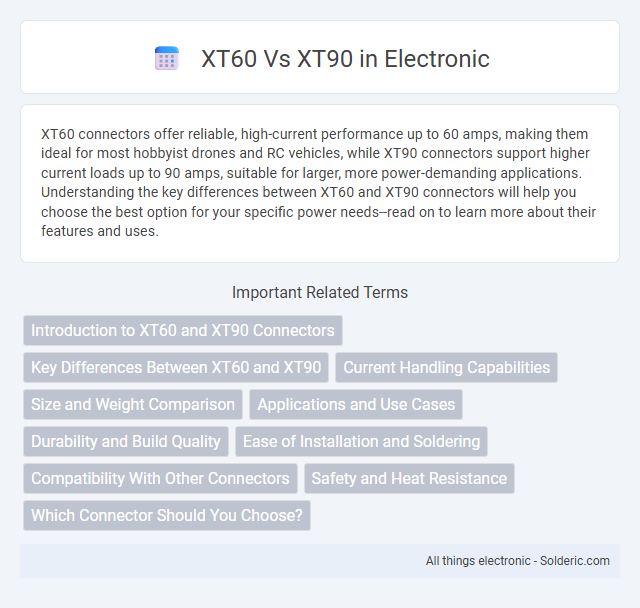XT60 connectors offer reliable, high-current performance up to 60 amps, making them ideal for most hobbyist drones and RC vehicles, while XT90 connectors support higher current loads up to 90 amps, suitable for larger, more power-demanding applications. Understanding the key differences between XT60 and XT90 connectors will help you choose the best option for your specific power needs--read on to learn more about their features and uses.
Comparison Table
| Feature | XT60 | XT90 |
|---|---|---|
| Current Rating | Up to 60A continuous | Up to 90A continuous |
| Connector Size | Medium (16mm x 13mm) | Larger (22mm x 12mm) |
| Typical Use | Small to medium RC models, drones, batteries | High-power RC models, large batteries, electric vehicles |
| Weight | ~5.1 grams | ~13.1 grams |
| Voltage Rating | Up to 500V | Up to 500V |
| Pin Material | Gold-plated brass | Gold-plated brass |
| Durability | Good for moderate use | Designed for heavy-duty applications |
| Compatibility | Compatible with XT60 connectors only | Compatible with XT90 connectors only |
Introduction to XT60 and XT90 Connectors
XT60 and XT90 connectors are high-current electrical connectors commonly used in RC vehicles, drones, and battery packs, designed to ensure secure and reliable power connections. The XT60, rated for 60 amps continuous current, features a compact design with gold-plated contacts to minimize resistance and prevent overheating. In contrast, the XT90 supports up to 90 amps continuous current, offering a larger form factor and enhanced durability for applications requiring higher power delivery.
Key Differences Between XT60 and XT90
XT60 and XT90 connectors differ primarily in their current rating and size; XT60 supports up to 60 amps while XT90 handles up to 90 amps, making XT90 suitable for higher power applications. The XT90 is larger and heavier, designed to provide better heat dissipation and a more robust connection under high load conditions. Choosing between XT60 and XT90 depends on your device's power requirements and ensuring optimal safety and performance during operation.
Current Handling Capabilities
XT60 connectors handle continuous currents up to 60 amps, making them ideal for moderate power applications such as small to medium-sized drones and RC vehicles. XT90 connectors support higher currents, typically up to 90 amps, suited for larger electric vehicles or high-power battery packs requiring more robust current delivery. Choosing the right connector depends on Your device's current demand to ensure safety and optimal performance.
Size and Weight Comparison
The XT60 connector measures approximately 21mm in length and weighs around 3 grams, making it compact and lightweight for small to medium battery applications. In contrast, the XT90 connector is larger, about 29mm long, and heavier, weighing roughly 6 grams, designed to handle higher current loads. Your choice between XT60 and XT90 should consider the size and weight constraints of your project, balancing space efficiency with power requirements.
Applications and Use Cases
XT60 connectors are widely used in small to medium-sized RC vehicles, drones, and battery packs due to their 60-amp current rating and compact design, making them ideal for lightweight applications requiring reliable power transfer. XT90 connectors support higher current loads up to 90 amps, making them suitable for larger electric vehicles, high-performance drones, and industrial battery systems where greater power demands and enhanced durability are critical. Both connectors are preferred in lithium polymer (LiPo) battery setups, with XT90 often chosen for applications involving high discharge rates and extended runtime.
Durability and Build Quality
XT90 connectors exhibit superior durability due to their thicker gold-plated contacts and reinforced housing, designed to handle higher current loads up to 90A without degradation. XT60 connectors, while robust and reliable for currents up to 60A, use slightly thinner contacts and less heavy-duty insulation, making them more susceptible to wear under extreme conditions. Both connectors utilize high-temperature nylon shells, but XT90's enhanced structure provides better resistance to physical stress and thermal expansion during extended use.
Ease of Installation and Soldering
XT60 connectors offer a more compact design and smaller soldering tabs, making them easier to handle and solder for beginners, while XT90 connectors feature larger tabs that require more heat and precision during soldering. The XT60's tighter fit and standardized housing reduce the chance of solder bridges and provide a more straightforward installation process. Your choice will depend on your experience level and the current rating needed, with XT60 favored for simpler setups and XT90 suited for heavier-duty applications.
Compatibility With Other Connectors
XT60 and XT90 connectors differ in size and current rating, affecting their compatibility with other connectors. XT60 connectors handle currents up to 60 amps and fit smaller cables, while XT90 connectors support up to 90 amps and thicker wires, limiting direct connection options between the two. You can use adapter cables or connectors specifically designed for bridging XT60 and XT90 connections to ensure safe compatibility across your devices.
Safety and Heat Resistance
XT90 connectors offer higher safety standards with a robust design that reduces the risk of short circuits and accidental disconnections compared to XT60 connectors. XT90 connectors are rated for currents up to 90 amps, which enhances heat resistance and prevents overheating during high current applications, making them ideal for demanding power systems. XT60 connectors, rated for 60 amps, provide reliable performance but are more prone to heat buildup under heavy loads, increasing the potential risk of connector failure.
Which Connector Should You Choose?
XT60 connectors are ideal for applications requiring currents up to 60A, making them perfect for smaller drones, RC cars, and battery packs with moderate power demands. XT90 connectors support up to 90A, suited for high-power devices and larger battery systems that need reliable, heat-resistant connections. Choose XT60 for lightweight setups where compact size and moderate current suffice, while XT90 is better for your high-current, heavy-duty requirements ensuring safety and efficiency.
XT60 vs XT90 Infographic

 solderic.com
solderic.com